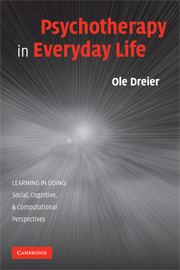Book contents
- Frontmatter
- Contents
- Series Foreword
- Preface
- Introduction
- 1 Re-Searching Psychotherapy as a Social Practice
- 2 Theorizing Persons in Structures of Social Practice
- 3 A Study – Its Design and Conduct
- 4 Clients' Ordinary Lives Plus Sessions
- 5 Therapy in Clients' Social Practice across Places
- 6 Changes in Clients' Practice across Places
- 7 Changing Problems across Places
- 8 The Conduct of Everyday Life and the Life Trajectory
- 9 The Children's Changing Conducts of Everyday Life and Life Trajectories
- 10 The Parents' Changing Conducts of Everyday Life and Life Trajectories
- 11 The Changing Conduct of Everyday Family Life and Family Trajectory
- 12 Research in Social Practice
- References
- Author Index
- Subject Index
- Learning in Doing: Social, Cognitive, and Computational Perspectives
6 - Changes in Clients' Practice across Places
Published online by Cambridge University Press: 15 December 2009
- Frontmatter
- Contents
- Series Foreword
- Preface
- Introduction
- 1 Re-Searching Psychotherapy as a Social Practice
- 2 Theorizing Persons in Structures of Social Practice
- 3 A Study – Its Design and Conduct
- 4 Clients' Ordinary Lives Plus Sessions
- 5 Therapy in Clients' Social Practice across Places
- 6 Changes in Clients' Practice across Places
- 7 Changing Problems across Places
- 8 The Conduct of Everyday Life and the Life Trajectory
- 9 The Children's Changing Conducts of Everyday Life and Life Trajectories
- 10 The Parents' Changing Conducts of Everyday Life and Life Trajectories
- 11 The Changing Conduct of Everyday Family Life and Family Trajectory
- 12 Research in Social Practice
- References
- Author Index
- Subject Index
- Learning in Doing: Social, Cognitive, and Computational Perspectives
Summary
In this chapter I characterize the main features of the changes in the clients' practice during the period of therapy. On this background, I shall focus on changes in relation to their problems in the next chapter.
Therapy is meant to promote changes that the clients bring about by linking aspects of their practices in different contexts. In comprehending client changes, we must, hence, capture the varying coincidences and links between sessions, life in the family, and other places in the clients' ongoing social practice. But the main parties in the practice of therapy spontaneously understand these complex, cross-contextual change processes from different locations in social practice and consider the role of circumstances and events in what from there appears as other places. Clients spontaneously view the changes from the location of their family and consider circumstances and events in other places, such as sessions, as playing a part in enabling and inhibiting changes here (Dreier 1991). Therapists (and researchers) view the changes from their location in sessions and must try to understand how what goes on here interacts with what goes on in other places where they are not present to observe and affect the changes. Besides, many circumstances and events are not mentioned in sessions because sessions cannot cover everything, therapists select some topics for examination, and clients do not mention what they consider irrelevant for curing their symptoms or do not want included in their therapy.
- Type
- Chapter
- Information
- Psychotherapy in Everyday Life , pp. 109 - 140Publisher: Cambridge University PressPrint publication year: 2007



